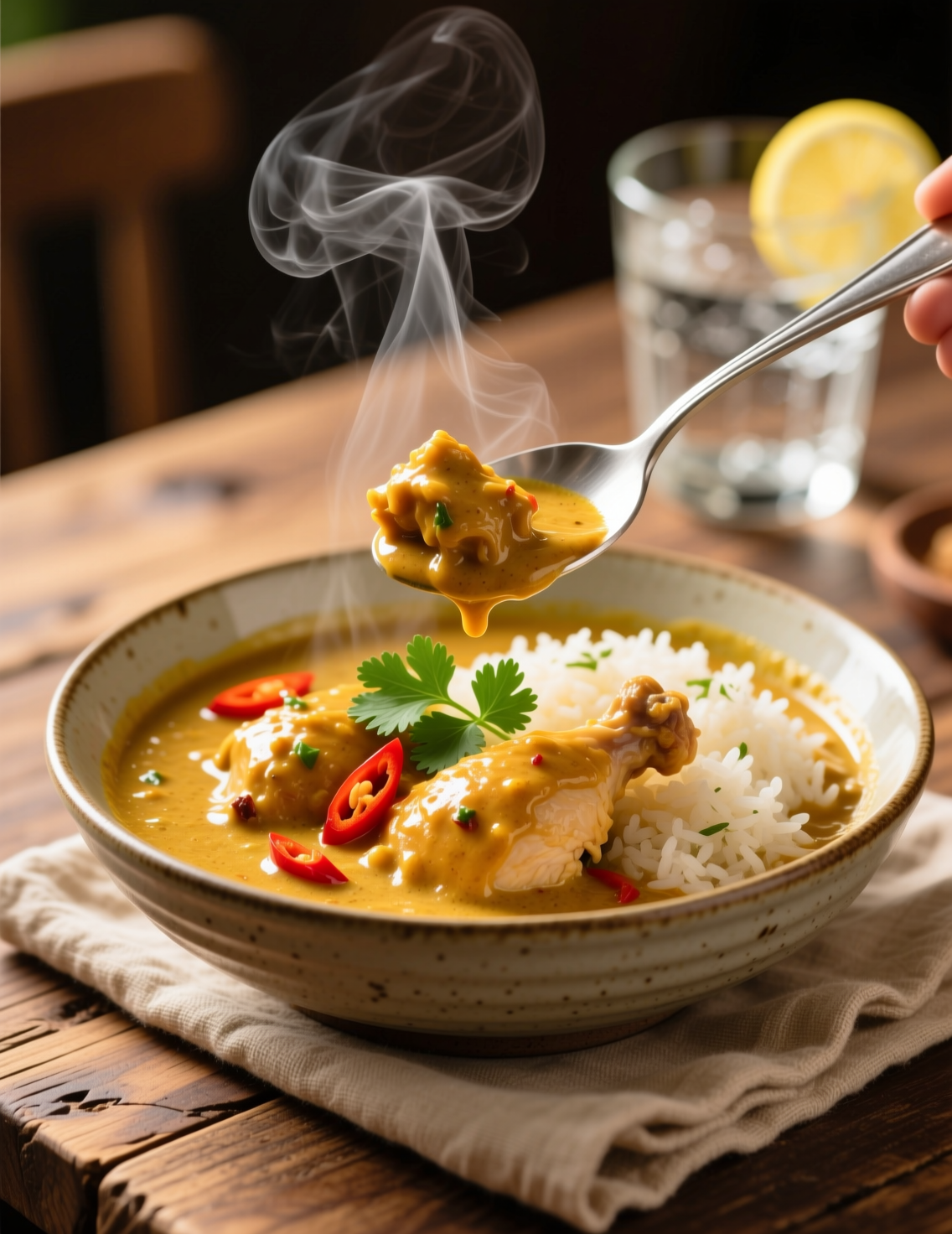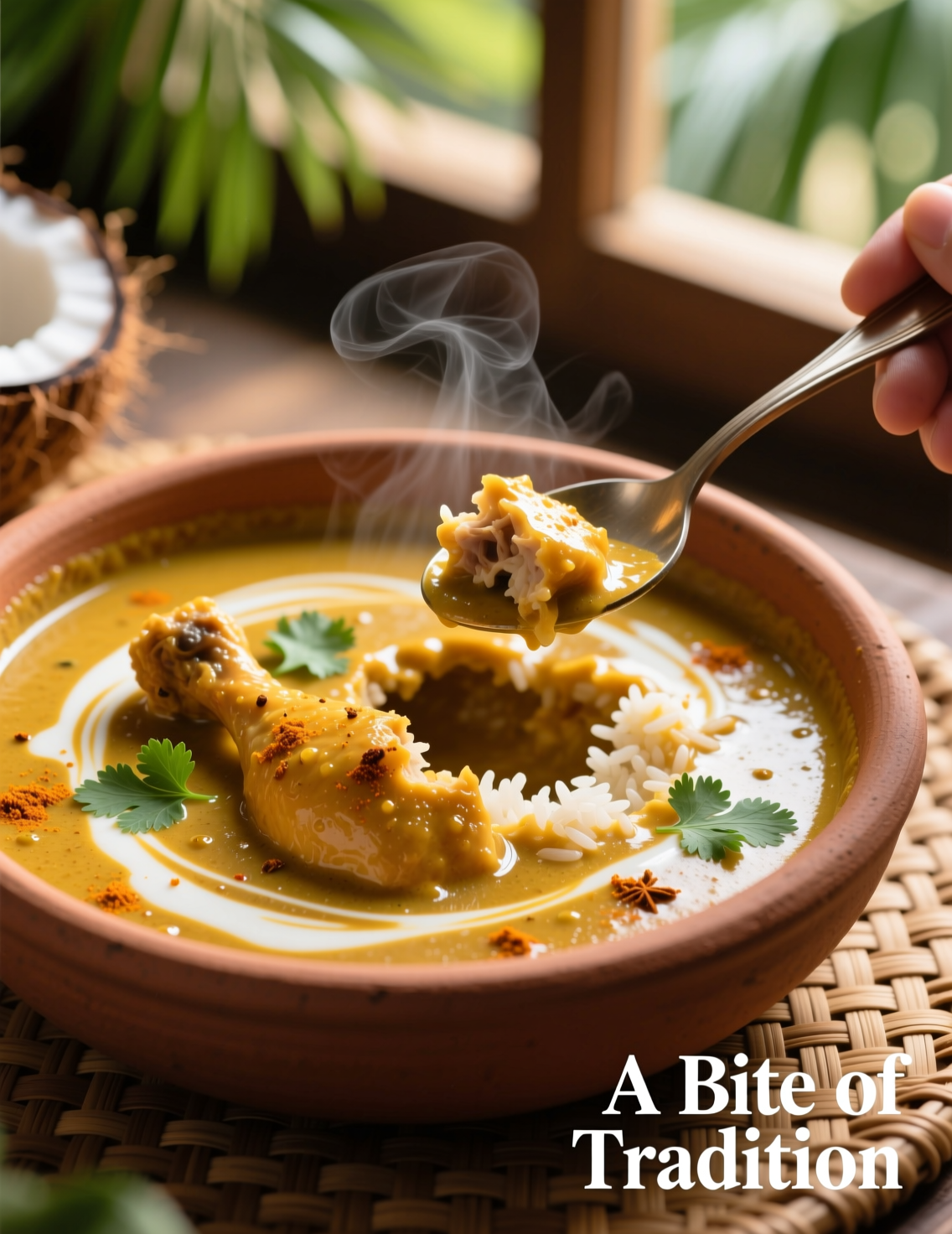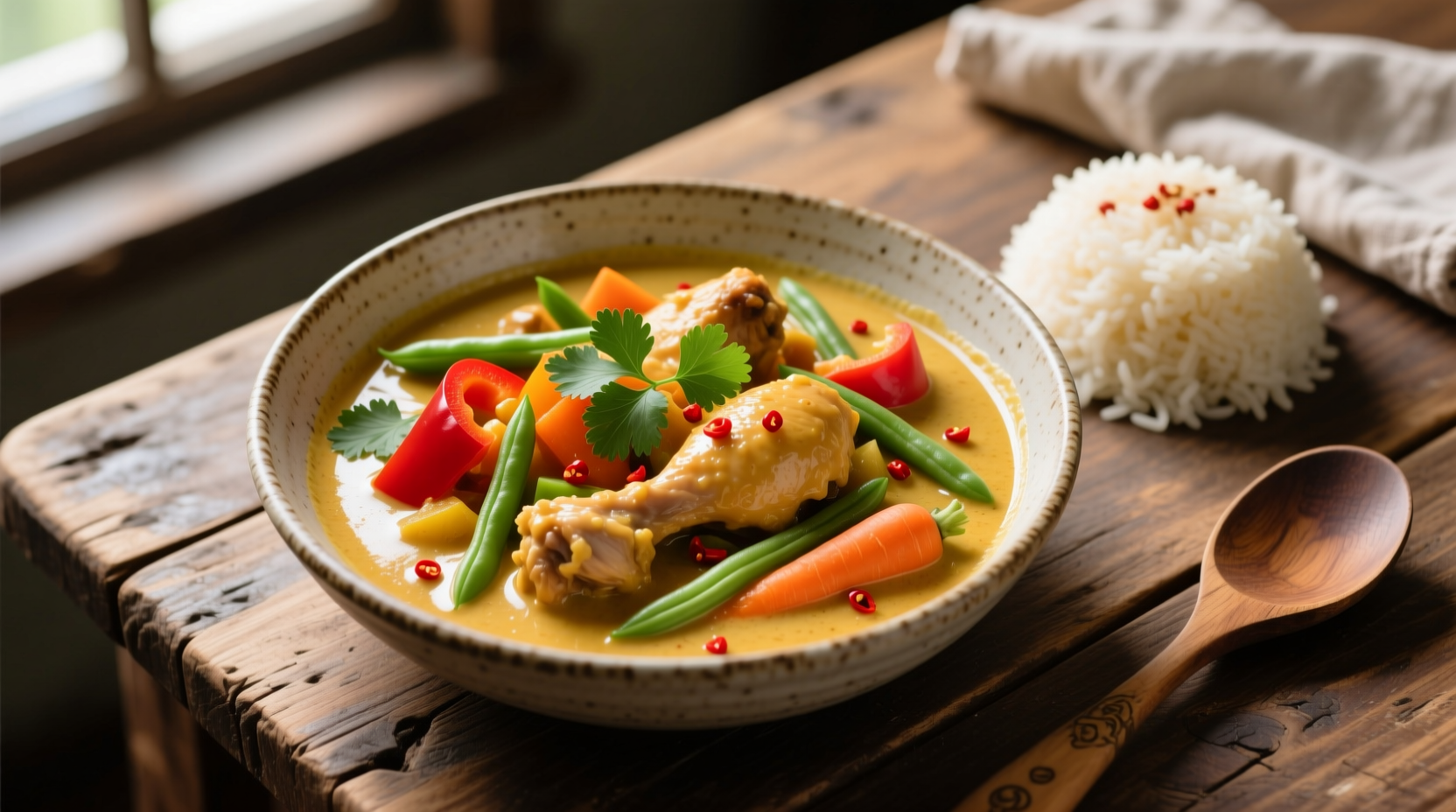When you think of curry, it’s hard not to imagine bowls of golden sauce, rich coconut cream clinging to tender chicken, and that unmistakable mix of spice and comfort. Coconut Curry Chicken isn’t just a weeknight dinner. It’s a dish with roots deep in Southeast Asia and India, shaped by trade, migration, and centuries of cooking wisdom. Today, I’ll break down how to make a professional-grade Coconut Curry Chicken recipe for 4 servings, while weaving in the little tricks, cultural notes, and technical details that separate good food from unforgettable meals.
Why Coconut Curry Chicken Works So Well
The pairing of coconut milk with curry spices is no accident. Coconut’s fat molecules carry and soften the sharpness of spices. Capsaicin from chili, the pungency of garlic, and even the earthy bitterness of turmeric mellow into harmony when stirred into coconut cream. Chefs often call coconut “a flavor magnifier,” because it stretches spice into every bite.
Chicken, on the other hand, provides protein that absorbs flavor quickly. Dark meat cuts—like thighs—stay juicy even under long simmering. Breast meat can work too, but it requires extra care to avoid dryness. When these two meet inside a pot, with heat coaxing out oils from curry spices, the result is a sauce that’s bold yet soothing.
Ingredients You’ll Need for 4 Servings
Professional kitchens measure everything, not to be fussy, but because flavor balance is math in disguise. Here’s the baseline recipe:
- 1.5 lbs chicken thighs, boneless, skinless (about 6 pieces)
- 2 tbsp coconut oil (or neutral oil if not available)
- 1 large onion, finely diced
- 4 cloves garlic, minced
- 1 tbsp fresh ginger, grated
- 2 tbsp curry powder (Madras style if you want heat, mild yellow for gentler flavor)
- 1 tsp ground turmeric
- 1 tsp ground cumin
- 1 tsp paprika
- 1–2 fresh chilies, sliced (optional, depends how brave you are)
- 1 can (13.5 oz) coconut milk, full fat
- 1 cup chicken stock (unsalted preferred)
- 1 medium tomato, chopped (adds acidity to cut richness)
- 1 tbsp fish sauce or soy sauce (umami depth)
- 1 tsp sugar (balances spice and tomato)
- Salt to taste
- Fresh cilantro leaves for garnish
- Steamed rice or flatbread for serving
This looks simple on paper, but every ingredient is working double duty. The sugar isn’t for sweetness, but balance. Fish sauce doesn’t taste fishy once simmered; it unlocks depth. Even the onion’s natural sugars caramelize into the sauce, giving complexity without announcing itself.

The Cooking Process, Step by Step
Heat isn’t just heat in cooking—it’s a tool you wield like a scalpel. How you control it changes everything.
Step 1: Build the Base
Warm coconut oil in a heavy-bottomed pot. Add onions and cook until golden brown, about 8–10 minutes. This isn’t rushing work. Browning onions is flavor investment. Too pale and the curry tastes flat. Too dark and it turns bitter.
Step 2: Introduce the Aromatics
Toss in garlic, ginger, and chilies. Stir for about 30 seconds until fragrant. The timing is important—garlic burns fast, and burned garlic is the bully of flavors.
Step 3: Toast the Spices
Sprinkle curry powder, turmeric, cumin, and paprika over the onion mix. Stir constantly for 1 minute. Spices bloom in oil, their volatile compounds releasing into the fat. Skip this step, and your curry will taste raw and dusty.
Step 4: Add the Chicken
Place chicken thighs into the pot, coating them in the spice mix. Sear each side lightly. You don’t need a deep crust here. The goal is to lock flavor onto the meat before the sauce takes over.
Step 5: Create the Sauce
Pour in coconut milk and chicken stock. Stir in tomato, fish sauce, and sugar. Bring everything to a gentle boil, then immediately lower to a simmer. Cover partly, letting steam escape. Simmer 25–30 minutes until chicken is fork-tender and sauce has thickened.
Step 6: Final Adjustments
Taste. Really taste. Does it need salt? More acid? A pinch of lime juice can lift everything at the end. The last-minute seasoning is what separates chefs from home cooks.
Step 7: Serve
Ladle curry over steamed jasmine rice, or scoop with warm naan. Sprinkle fresh cilantro. The dish should look glossy, smell complex, and taste like the work of both patience and fire.
Professional Tips You Rarely Hear
- Always cook curry a day in advance if you can. The flavors marry overnight in a way no fresh simmer can replicate. Many Indian restaurants rely on this secret.
- If coconut milk “splits” in the pot, don’t panic. It just means the fat separated. A vigorous stir or splash of stock brings it back together.
- Adding ground spices is only half the story. For deeper flavor, consider adding a cinnamon stick, cardamom pods, or curry leaves while simmering. Whole spices perfume sauces differently than ground ones.

The Science of Flavor in Coconut Curry
Researchers in food chemistry have long studied why curry is globally beloved. A 2015 study from Food Research International found that turmeric and ginger compounds activate multiple taste receptors simultaneously. Coconut fat enhances this perception by slowing flavor release in the mouth. That’s why one bite lingers so long.
Protein also matters. Chicken has glutamic acid, a natural source of umami. Combine that with fish sauce’s nucleotides, and you get a phenomenon called “umami synergy.” In short, one plus one equals three on the tongue.
Common Misconceptions About Curry
One of the biggest myths: curry is a single spice. It’s not. It’s a blend, and every region has its own fingerprint. Thai curries rely on fresh pastes—lemongrass, galangal, kaffir lime. Indian curries lean on dried spice powders, slow-cooked onions, and layered techniques. Coconut Curry Chicken is a hybrid, often drawing on Indian spice structure with Southeast Asian coconut milk.
Another misconception is that curry must be fiery hot. Heat is cultural. In Kerala, coconut-based curries are mellow and soothing. In Northern Thailand, the same base might blister your lips. The beauty is flexibility—you make it your own.
Variations Worth Exploring
Once you master the classic recipe, tweaking becomes second nature.
- Vegetable Boost: Add cubes of sweet potato or butternut squash. They soak flavor like sponges.
- Seafood Swap: Replace chicken with shrimp or firm white fish. Cut cooking time in half.
- Vegan Version: Use tofu or chickpeas, vegetable stock, and extra coconut cream for body.
- Fragrant Finish: Stir in a spoon of Thai basil or kaffir lime leaves at the end for an aromatic punch.
Serving and Pairing Ideas
Coconut Curry Chicken loves company. Steamed jasmine rice is classic, but sticky rice brings more chew. Roti, naan, or parathas let you scoop sauce without cutlery. For drinks, a crisp lager cuts richness. Riesling wine, slightly off-dry, complements spice without fighting it. Even coconut water chilled with lime makes a perfect non-alcoholic pairing.
Nutrition and Health Insights
For professionals thinking beyond flavor, this dish balances macronutrients smartly. A serving (roughly calculated) contains about:
- Calories: ~480
- Protein: 32g
- Fat: 28g (mostly from coconut and chicken)
- Carbs: 15g (mostly from tomato and onion, without rice)
Coconut fat is mostly medium-chain triglycerides (MCTs), which metabolize faster than long-chain fats. Some studies suggest MCTs support energy and satiety. The turmeric brings curcumin, known for anti-inflammatory properties. Garlic and ginger contribute antimicrobial and digestive benefits. This isn’t just tasty—it’s food with function.
A Real-World Example
I once trained a team of young cooks in Bangkok, teaching them this very curry. They came from different regions—some used more chili, some added palm sugar, one even tossed in pineapple. The room smelled like ten different curries. Yet every version carried the same DNA: coconut’s soft hug around sharp spice. That’s the beauty of this dish—it welcomes interpretation without losing its soul.
Emerging Trends with Coconut Curry
Professional kitchens are pushing curry into new territory. Some chefs serve coconut curry as a deconstructed plate—crispy chicken skin on one side, concentrated curry sauce poured tableside. Others are experimenting with low-fat coconut milk to meet health demands, though many argue the body of the sauce suffers. Plant-based versions are booming too. Chickpea coconut curry ranks among the most searched vegan recipes globally in 2024, showing its universal appeal.
Troubleshooting Common Issues
- Too Watery: Simmer uncovered for the last 10 minutes, letting moisture evaporate.
- Too Spicy: Add more coconut milk or a spoon of yogurt. Dairy neutralizes capsaicin.
- Too Bland: Often means under-toasted spices or under-salted stock. Don’t fear salt—it’s a flavor amplifier, not the enemy.
Conclusion: Why This Recipe Endures
Coconut Curry Chicken isn’t a trend. It’s a dish that has lived in kitchens for centuries and continues to evolve in professional and home cooking alike. For four servings, it’s affordable, flexible, and deeply satisfying. But more than that, it teaches every cook a lesson: balance is everything. Spice needs fat. Heat needs sweetness. Protein needs acid.
Cook it once, and you’ll taste comfort. Cook it often, and you’ll understand why chefs revere it as a canvas for creativity. That’s the secret—it’s not just a recipe, it’s a way of learning how flavors talk to each other.
FAQs
What type of chicken works best for coconut curry chicken?
Boneless, skinless chicken thighs hold moisture and flavor better than breast meat.
Can I make coconut curry chicken ahead of time?
Yes, it tastes even better the next day as the flavors meld overnight.
How do I stop coconut milk from splitting in curry?
Keep heat gentle and stir often; a splash of stock can bring it back together.
Is coconut curry chicken very spicy?
It depends on your chili level—mild without chilies, fiery if you add more.
Can I substitute light coconut milk instead of full-fat?
You can, but the sauce will be thinner and less rich in flavor.
What’s the best side dish to serve with coconut curry chicken?
Steamed jasmine rice or naan bread pairs beautifully with the curry sauce.
Can I freeze coconut curry chicken?
Yes, it freezes well for up to 2 months; reheat gently to keep the sauce smooth.
How do I make the curry vegetarian or vegan?
Replace chicken with chickpeas, tofu, or vegetables, and use vegetable stock.
Why does my curry taste bland sometimes?
Most likely the spices weren’t toasted enough or you need more salt.
How long should coconut curry chicken simmer?
Around 25–30 minutes is ideal for tender chicken and a thickened sauce.

Mariana is a passionate home cook who creates delicious, easy-to-follow recipes for busy people. From energizing breakfasts to satisfying dinners and indulgent desserts, her dishes are designed to fuel both your body and hustle.
When she’s not in the kitchen, she’s exploring new flavors and dreaming up her next recipe to share with the Foodie Hustle community.

